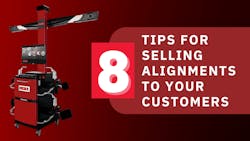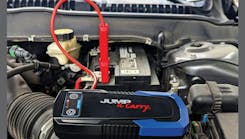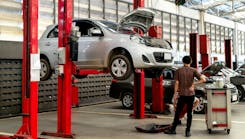Selling Wheel Alignment 101: A guide for auto shops
Wheel alignment, often overlooked by vehicle owners, is a critical aspect of vehicle maintenance. It plays a significant role in ensuring safety, prolonging tire life, and enhancing the overall driving experience. As an automotive shop, effectively selling wheel alignment to customers is not only a service but also a value-added solution that benefits both your business and your clients.
Let’s explore the strategies for successfully selling wheel alignment to your customers when it’s needed.
1. Initial assessment
Begin by conducting a preliminary assessment of the customer’s vehicle. This could involve a visual inspection of their tires to check for uneven wear, taking note of any steering issues they’ve mentioned, or by running a “Quick Check” on your alignment machine. This first step will help determine the state of the vehicle’s alignment and give you the insights to guide the customer in the right direction.
2. Explain the process
Next, be sure to explain the wheel alignment process in simple terms. Let them know that it involves adjusting the angles of their wheels to manufacturer specifications, ensuring that the tires meet the road at the correct angle. To put it another way, you could compare vehicle wheel alignment to tuning a musical instrument. Just as tuning ensures that each string produces the right note, wheel alignment ensures that each wheel on the vehicle is perfectly positioned to work in harmony.
When your vehicle’s wheels are aligned correctly, it performs smoothly, handles well, and provides a safe and comfortable ride, much like a well-tuned instrument. On the other hand, misaligned wheels can be likened to out-of-tune strings, leading to an unpleasant and inefficient driving experience.
For customers who may want to know more about the alignment, you can take a few moments to explain the areas that are looked at during the alignment process. There are three areas that are checked during a wheel alignment that help the technician see the amount of wear and tear present. The camber is the angle of the tires when viewed from the front, and if there is too large of an angle inward or outward, this means your customer’s vehicle is misaligned. The toe is the view of the angle from above, if the angle is too large inward or outward tilting this means an alignment is needed.
Finally, the caster is the view of the angle of the tires when viewed from the side, which can impact the steering, handling, and stability of your customer’s vehicle. You don’t have to go into all these details when explaining this, but it can help your customer understand the importance of wheel alignment and why it is needed on their vehicle.
3. Safety first
Safety is a paramount concern for drivers. Highlight how proper wheel alignment contributes to vehicle stability, reduces the risk of accidents, and enhances overall safety. Too much wear on the front or rear tires will also cause the responsiveness of your customer’s vehicle to decrease. This could be potentially dangerous in situations where they need to brake quickly or navigate slippery road conditions, potentially jeopardizing the safety of your customers and those around them.
Share relevant statistics and real-life examples to underscore this point. Some relevant statistics on wheel alignment include: Something to point out here is that tires are arguably the most important safety feature in a car since it’s the only part of the vehicle touching the road. So, making sure they stay in good condition to perform properly is critical for safety.
4. Cost savings
Not only is a misaligned vehicle unsafe, but it’s also not great for your customer’s wallet. Emphasize the cost-saving aspect. Misaligned wheels lead to uneven tire wear, necessitating more frequent tire replacements. Tires are expensive to replace, so explain to your customer that by getting a wheel alignment now they are investing in the future of their vehicle. Aligning the wheels now can save customers money in the long run.
5. Improved fuel efficiency
Point out that proper alignment can lead to improved fuel efficiency. Misaligned wheels create more resistance, causing the vehicle to work harder and consume more fuel. According to the U.S. Environmental Protection Agency (EPA) report, cars experiencing wheel alignment issues may observe a fuel efficiency reduction of approximately 7 percent. For a vehicle owner traveling 14,000 miles annually with an average of 25 miles per gallon at a fuel cost of $4.00 per gallon, ensuring proper wheel alignment could result in an annual fuel cost reduction of about $150. It’s clear that a wheel alignment can lead to significant savings at the gas pump.
6. Enhanced driving experience and longevity of vehicle
Describe how proper alignment enhances the driving experience. It results in smoother steering, better handling, and a more comfortable ride. Customers will appreciate the difference, especially during long journeys. Explain that wheel alignment isn’t just about tires; it’s about extending the life of the entire vehicle. When customers keep up with their vehicle’s wheel alignments, they help maintain the integrity of their vehicle, increasing its ability to serve them for a longer period of time. Misalignment can cause premature wear and tear on various components, potentially leading to expensive repairs down the road.
7. Customization
When talking about alignment, make sure you’re considering the vehicle’s use. If applicable, mention that alignment can be customized to the customer’s driving habits. For instance, high-performance vehicles or those that often carry heavy loads may benefit from specialized alignment adjustments, improving both performance and safety.
8. Visual aids
Use visual aids to illustrate alignment issues and solutions. Diagrams or computer-generated reports can show customers their current alignment status and how it should ideally be. Visuals help customers understand the problem and the proposed solution.
The most important thing to keep in mind is to always present wheel alignment as a RECOMMENDATION no matter how strong, rather than a pushy sales pitch. Let customers know that it’s a service that can help their vehicle and safety, but ultimately, the decision is theirs to make.
By educating customers about the importance of wheel alignment and addressing their concerns, you not only build trust but also contribute to safer roads and more satisfied vehicle owners. So, make wheel alignment a priority in your service offerings and watch your business thrive while keeping your customers safe on the road.
Information provided by The Coats Company


